The HF station
The HF station comprises a minimalist approach to the HF bands!
Activity started mainly with the hombrew 10 watt solid state transceiver (right). When the 5Mhz (60m) band was issued, the 7Mhz part of this rig was modified and it was used mainly on 60m. The transceiver was based on the G3TSO Mk 2 design with a 9Mhz IF and made use of the Plessey series of SL 600 series of IC's thoughout. A basic 5-5.5Mhz FET VFO was used in conjunction with a mixer and switched crystal oscillators to mix to the various HF bands. The output power was raised to the 10watt level in a solid state amplifier which used to be marketed in kit form by Cirkit.
This radio has now been replaced by the SDR project outlined below.
The solid state transceiver was complemented by a homebrew VALVE linear (second right) using a pair of 6146's to run about 60W on all bands. An FT-77 transceiver is also used to cover the WARC bands.
The main antenna comprises an 80 foot long, doublet used on 80m to 10m at 25feet agl , with an LDG matching unit. A quarter wave vertical can also be used on 10m.
My current activity is on SSB, WSPR and FT8. The latter two modes require a high order of frequency stability and a DDS based high stabilty 5MHz external VFO is used on the FT-77 radio. The SDR transceiver however us already stable enough for these modes.
This radio has now been replaced by the SDR project outlined below.
The solid state transceiver was complemented by a homebrew VALVE linear (second right) using a pair of 6146's to run about 60W on all bands. An FT-77 transceiver is also used to cover the WARC bands.
The main antenna comprises an 80 foot long, doublet used on 80m to 10m at 25feet agl , with an LDG matching unit. A quarter wave vertical can also be used on 10m.
My current activity is on SSB, WSPR and FT8. The latter two modes require a high order of frequency stability and a DDS based high stabilty 5MHz external VFO is used on the FT-77 radio. The SDR transceiver however us already stable enough for these modes.

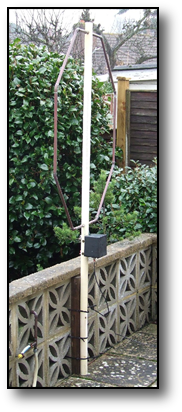
I have been listening on the 472khz band using the loop shown here, together with a pre-amp and a homebrew converter which upconverts 472khz to the 144Mhz band.
Some experiments have been made with a couple of vertical antennas.
The first shown here is a capacitively end loaded vertical diplole covering 40m to 10m with appropriate matching coils at the centre.
Results so far seem to indicate its no worse than my 80 foot long wire antenna and does seem to be quieter. The disadvantage is the need to change the matching coils when a band change is made although with time this could be made automatic.
The first shown here is a capacitively end loaded vertical diplole covering 40m to 10m with appropriate matching coils at the centre.
Results so far seem to indicate its no worse than my 80 foot long wire antenna and does seem to be quieter. The disadvantage is the need to change the matching coils when a band change is made although with time this could be made automatic.
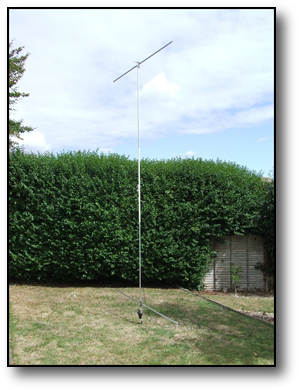
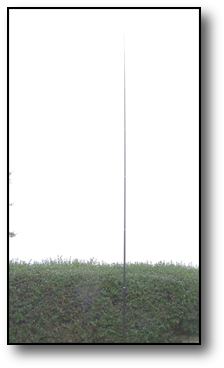
The second antenna tried was a 1/2 wave vertical for 17m shown here.
This was made from a telescopic fibre-glass fishing pole, bought on eBay, with a thin wire stretched to the top and a small matching network at the bottom.
This was made from a telescopic fibre-glass fishing pole, bought on eBay, with a thin wire stretched to the top and a small matching network at the bottom.
JT65 on HF
I have tried JT65 on 30 ---> 10m. This seemed to work quite well.
I used the W6CQZ software downloaded free on line on a 2.4Ghz dual core Pentium desk top Dell Optiplex PC. I've also tried FT8 but still prefer JT65 but its use is dying out now due to the popularity of the latter mode.
I used the W6CQZ software downloaded free on line on a 2.4Ghz dual core Pentium desk top Dell Optiplex PC. I've also tried FT8 but still prefer JT65 but its use is dying out now due to the popularity of the latter mode.
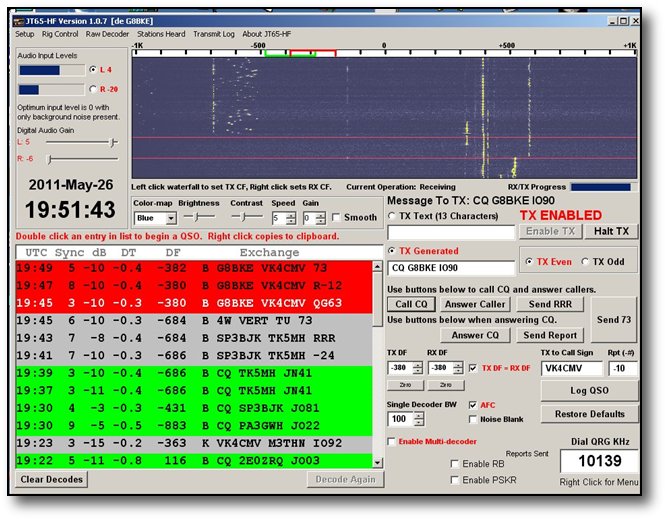
mcHF SDR HF Transceiver Project
A project started in 2017, has been to homebrew a 5watt HF SDR transceiver from pcbs available on line. It all went together well as can be seen from the photos here, with parts available mainly from Farnell and other on line suppliers. It comprises two pcbs, one containing most of the RF components, the second the display and processor etc.
It seems to give a good account of itself connected to the doublet antenna despite its low power.
An example of it in operation on 60m can be seen here while on test lash-up form.
More details on the kit and the radio here
It seems to give a good account of itself connected to the doublet antenna despite its low power.
An example of it in operation on 60m can be seen here while on test lash-up form.
More details on the kit and the radio here
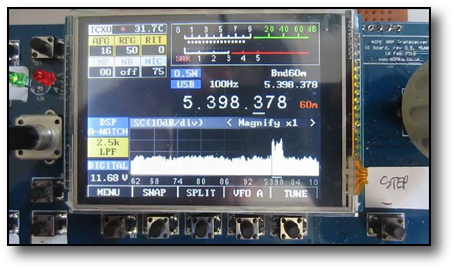
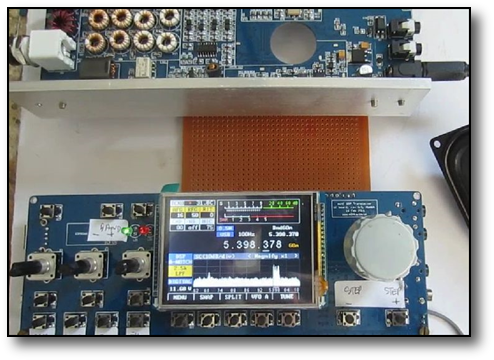


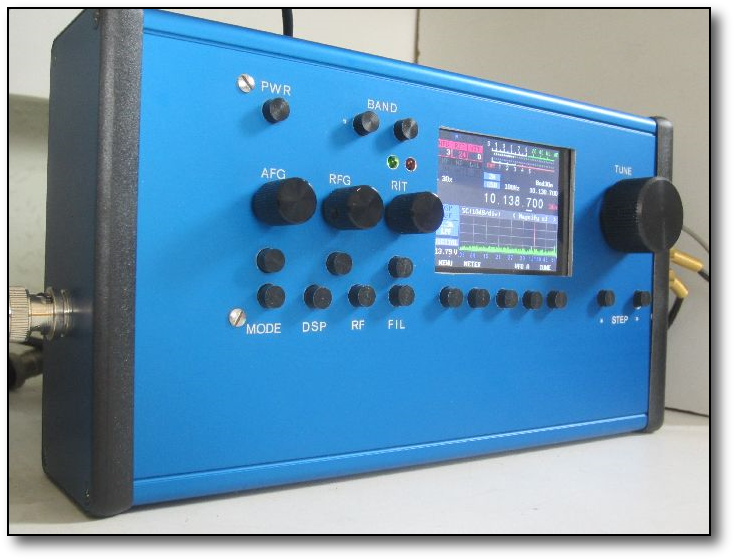
After what seemed like an eternity I eventually selected a case for it and finished it off in 2019.
No originality is claimed for the case choice as PA0KME had already made an excellent choice with his radio, so I decided to follow the same route.
No originality is claimed for the case choice as PA0KME had already made an excellent choice with his radio, so I decided to follow the same route.
I have also tried transmitting WSPR on 472khz afterI cobbled up a 10W
Tx and adapting the doublet for that band.
Tx and adapting the doublet for that band.
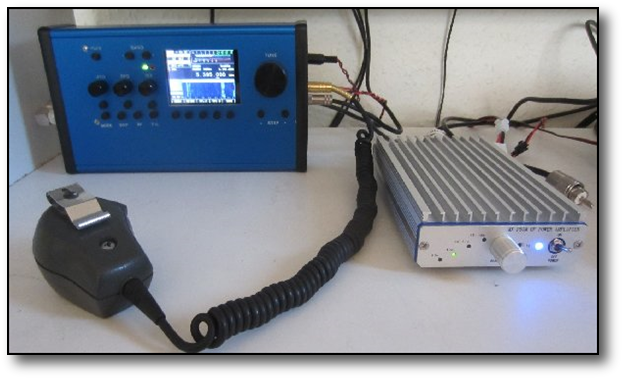
A recent addition to this rig has been a commercial amplifier type MX-P50M made in China (where else !?) shown here on the right, which raises the nominal level of 5W of the basic rig to 40W output.
I have always promised myself one of the new all singing and dancing rigs to see what I was missing in the way of additional bells and whistles so I decided to try the Yaesu FTDX 3000. Not the newest of the modern rigs but enough to tax my remaining brain cells. So far I seem to have mastered most of the buttons and had a few qsos but I'm not convinced yet that it offers anything more than my FT77 although it does cover 5MHz.
